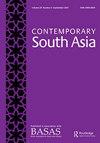The political life of Muslim caste: articulations and frictions within a Pasmanda identity
IF 0.5
3区 社会学
Q3 AREA STUDIES
引用次数: 1
Abstract
ABSTRACT The topic of Muslim caste has been getting space in media discourse and national politics recently through the concept of ‘Pasmanda’ – a term which refers to lower-caste Muslims. As the term gets wider purchase, it is important to question the concept and the category. What is the relationship of the category of Pasmanda with Muslim caste? Which struggles of Muslim lower castes is the term Pasmanda able to lend voice to, and what are the tensions encompassing the category. Through ethnographic fieldwork conducted in Varanasi, Uttar Pradesh, I examine a newly established organisation called the Pasmanda Adhikār Manch to explore how different single-caste associations come together under the Pasmanda banner. The caste-associations of the Halalkhor, Shah, and Nanpuz communities have the difficult task of countering the invisibilisation of Muslim caste not only by the state, but by their own caste brethren. They have limited room to demand anything from the state, considering that it hardly acknowledges the existence of their caste groups and is suspicious of their political claims as Muslims. Coming together under the Pasmanda umbrella helps provide a wider platform for assertion of Muslim caste. However, the category comes with limitations that threatens to undo its purpose.穆斯林种姓的政治生活:Pasmanda身份中的表达和摩擦
最近,通过“Pasmanda”(一个指低种姓穆斯林的术语)的概念,穆斯林种姓的话题在媒体话语和国家政治中获得了空间。随着这个术语越来越广泛,质疑这个概念和类别是很重要的。帕斯曼达与穆斯林种姓的关系是什么?“Pasmanda”这个词能够表达的是穆斯林低种姓的哪些斗争,以及围绕这一类别的紧张关系是什么。通过在北方邦瓦拉纳西进行的人种学田野调查,我研究了一个名为Pasmanda Adhikār Manch的新成立的组织,以探索不同的单一种姓协会如何在Pasmanda的旗帜下走到一起。Halalkhor, Shah和Nanpuz社区的种姓协会面临着一项艰巨的任务,即不仅是国家,而且是他们自己的种姓兄弟对穆斯林种姓的隐形化。考虑到政府几乎不承认他们的种姓群体的存在,而且对他们作为穆斯林的政治主张持怀疑态度,他们向政府提出任何要求的空间有限。在Pasmanda的保护伞下聚集在一起,有助于为穆斯林种姓的主张提供更广泛的平台。然而,这个类别也有一些限制,可能会破坏它的目的。
本文章由计算机程序翻译,如有差异,请以英文原文为准。
求助全文
约1分钟内获得全文
求助全文
来源期刊

Contemporary South Asia
AREA STUDIES-
CiteScore
2.10
自引率
0.00%
发文量
82
期刊介绍:
The countries of South Asia - Bangladesh, Bhutan, India, Maldives, Nepal, Pakistan and Sri Lanka - are internally diverse and part of global flows of people, goods and ideas. Contemporary South Asia seeks to address the issues of the region by presenting research and analysis which is both cross-regional and multi-disciplinary. The journal encourages the development of new perspectives on the study of South Asia from across the arts and social sciences disciplines. We also welcome contributions to pan-regional and inter-disciplinary analysis. Our aim is to create a vibrant research space to explore the multidimensional issues of concern to scholars working on South Asia and South Asian diasporas in the postcolonial era.
 求助内容:
求助内容: 应助结果提醒方式:
应助结果提醒方式:


